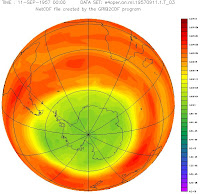The 16th of September is the International Day for the Preservation of the Ozone Layer, this year the theme is: ‘HCFC phase-out a unique opportunity’. To commemorate the day, UNEP has announced the release of a new report entitled: Risk Assessment on Illegal Trade in HCFCs. This report provides a summary of recent cases of illegal trade in HCFCs and the policy measures in place to combat smuggling of ozone depleting chemicals.
The Ozone layer protects the earth's inhabitants from harmful UV radiation and is essential for life on Earth, as it screens out lethal UV-B radiation. Increased UV-B from ozone depletion can lead to skin cancer, cataracts, weakened immune systems, reduced plant yield, damage to ocean eco-systems and damage to things like wood and plastic. The Montreal Protocol focuses on the protection of the earth's ozone layer.
The International Day for the Preservation of the Ozone Layer or ("Ozone Day"), is an official UN day commemorating the date in 1987 on when the Montreal Protocol on Substances that Deplete the Ozone Layer was signed.
The international community adopted the Montreal Protocol on Substances that Deplete the Ozone Layer to protect the earth from harmful ultraviolet radiation. In more than 24 years of successful implementation, the Protocol has been gradually strengthened to cover the phase-out of nearly 100 ozone-depleting substances. The latest adjustments were adopted in 2007 to accelerate the phase-out of hydrochlorofluorocarbons, or HCFCs.
The Montreal Protocol has enabled both developed and developing countries to achieve a near total phase-out in the production and use of most ozone depleting substances. Because the majority of ozone depleting substances are also potent global warming gasses, the actions taken under the Montreal Protocol have contributed significantly to the global effort to address climate change.
"The Montreal Protocol is a great example of what can be accomplished if nations, industry, technologists and scientists all combine to work on a problem," said Paul Newman from NASA's Goddard Space Flight Center.
United Nations Secretary General Kofi Annan, termed the Montreal Protocol "perhaps the single most successful international environmental agreement to date".
Despite these efforts, there is still a hole in the ozone over the Antarctic that will take decades to close. Global observations have verified that atmospheric levels of key ozone depleting substances are going down and it is believed that with implementation of the Protocol's provisions the ozone layer should return to pre-1980 levels by 2050 to 2075. However, in August the World Meteorological Organization (WMO) reported that signs of ozone depletion were again appearing over the Antarctic.
For these reasons, the OzonAction Programme of the United Nations Environment Programme (UNEP) has created a documentary called, The Antarctic Ozone Hole: From Discovery to Recovery. The documentary examines the current state of the ozone layer, the effects of ozone depletion on climate change and the potential impact on communities worldwide. The documentary had a worldwide screening on September 16, to mark the International Day for the Preservation of the Ozone Layer. The Antarctic Ozone Hole: From Discovery to Recovery offers solutions to reducing ozone depletion. The film reviews how the Montreal Protocol, can deliver immediate climate benefits. See the trailer here.
Screenings of the film include a launch in Nairobi where UNEP has its headquarters, and at the Biosphère Environment Museum in Montreal, the city where the Protocol was signed. The video is available in English and French here.
© 2011, Richard Matthews. All rights reserved.
Related Posts
The Montreal Protocol Celebrates
Video: Trailer for The Antartic Ozone
Home
action on climate change
benefits
benefits outweigh the costs
climate change science
Day to Protect Ozone
environmental
event
International Ozone Day
Ozone Day
science
U.N.
International Day for the Preservation of the Ozone Layer
- Blogger Comment
- Facebook Comment
Subscribe to:
Post Comments
(
Atom
)

0 comments:
Post a Comment